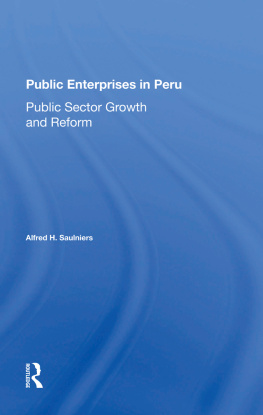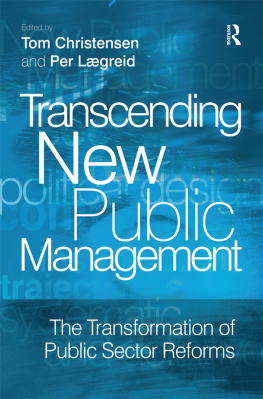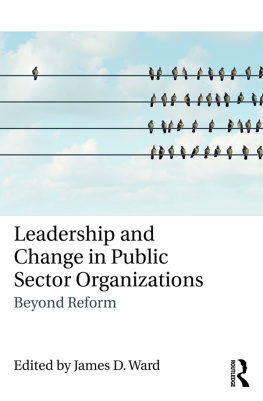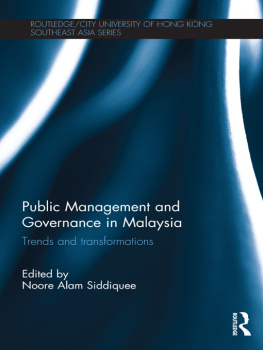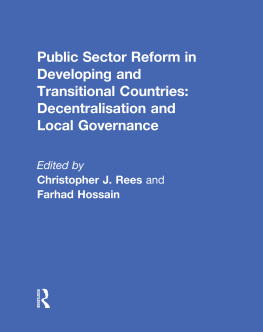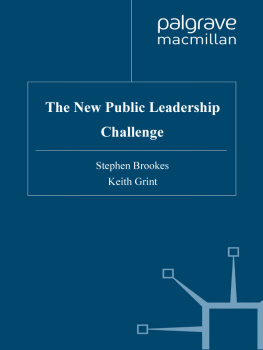First published 1988 by Westview Press
Published 2019 by Routledge
52 Vanderbilt Avenue, New York, NY 10017
2 Park Square, Milton Park, Abingdon, Oxon OX14 4RN
Routledge is an imprint of the Taylor & Francis Group, an informa business
Copyright 1988 by Taylor & Francis
All rights reserved. No part of this book may be reprinted or reproduced or utilised in any form or by any electronic, mechanical, or other means, now known or hereafter invented, including photocopying and recording, or in any information storage or retrieval system, without permission in writing from the publishers.
Notice:
Product or corporate names may be trademarks or registered trademarks, and are used only for identification and explanation without intent to infringe.
Library of Congress Cataloging-in-Publication Data
Saulniers, Alfred H., 1945
Public enterprises in Peru.
(Westview special studies on Latin America and the
Caribbean)
Bibliography: p.
Includes index.
1. Government business enterprisesPeru. I. Title.
II. Series.
HD4123.S28 1988 338.7'4'0985 87-34602
ISBN 13: 978-0-367-28467-1 (hbk)
This book helps fill the void in teaching materials about the Latin American public sector. It began as two case studies of public enterprises jointly carried out by the Office for Public Sector Studies of the University of Texas at Austin, which I directed, and the Universidad del Pacfico in Lima. Over the years, the cases expanded into a detailed analysis of the overall growth and dynamics of Peru's rapidly changing government portfolio. The resulting book focuses on the external environment for public enterprise action and develops an interlinkage framework to explain the dynamics of company growth, finances, efficiency, and profits in response to changes in that environment.
The manuscript took shape during a year's leave from the Austin campus, during 1983 and 1984, spent in East Africa in association with the Eastern and Southern African Management Institute in Arusha, Tanzania. The strong, positive reactions from government officials and public enterprise managers of Kenya, Tanzania, and Uganda to the lectures I gave about the Peruvian case testified to the broader applicability of the interlinkage framework in explaining company behavior and led to publication in Tanzania of an early version of excerpts of the sixth chapter (Saulniers, 1985f).
After my return to Austin, Richard Webb, then President of Peru's Central Bank, and Carlos Zuzunaga, President of the Peruvian Center for Applied Research, with assistance from the Friedrich Ebert Stiftung, provided me a unique opportunity, namely a forum to test out my ideas about Peru's public enterprises' relationships to the government before a group of Peruvian public enterprise managers and government officials. The debate during the two-day seminar proved lively, the criticisms well founded, and the experience both enlightening and humbling. The published results of the seminar have fueled the debate about the role of public enterprises in Peru from 1968 to 1980 (Saulniers, 1985g).
A six-week stay at the Universidad del Pacfico, under the auspices of the Fulbright Commission, enabled me to update the material in the manuscript and provided countless opportunities for discussions with colleagues there, at other universities, and throughout the government. My seminars to public enterprise executives at Pacfico and at the Graduate School of Business, ESAN, forced me to revise my ideas about the influence on decision making of time constraints and other pressures faced by managers in actual practice. Additionally, my lecture in the Applied Workshop Series sponsored by the Friedrich Ebert Stiftung gave me the chance to pull together several of the more provocative themes, having a broad Latin American impact, for presentation to a highly qualified Peruvian audience (Saulniers, 1985e). The spirited exchange contributed to further revisions and, hopefully, to a more meticulous book.
This book would not have been possible without the encouragement and support of Bill Glade who, as Director of the Institute of Latin American Studies, was instrumental in shaping the debate about the nature of the public enterprise process in Latin America. He urged Publication of preliminary findings from as part of the Technical Papers Series of the Office for Public Sector Studies (Saulniers, 1985h). His keen interest in the evolution of the Peruvian portfolio and its meaning for understanding the problematique of public enterprises spurred me to detail the Peruvian evolution in a more thorough fashion than available elsewhere, while remaining conscious of the implications of the evolving paradigm for public enterprise studies in general.
Outside of Peru, several colleagues, eminent pubic enterprise or public administration scholars and practitioners In their own right, have read all or parts of early drafts of the manuscript. They include Gene Bigler in Washington, Edwin Jones in Jamaica, lames Katorobo in Tanzania, V.V. Ramanadham and Barbara Grosh in Kenya, Enrique Saravia in Brazil, and Henry Dietz, Bill Glade, and Larry Graham in Austin. Former students, Peruvians and Peruvianists, read the manuscript as well, including Brian Branch, Louis DiSipio, Greg Estep, Luis Fernandez, Conrad Herold, and Julio Revilla. While the manuscript draws much of its strength from the detailed and pointed comments of these readers, any remaining deficiencies are mine. Finally, successive generations of students in my graduate seminar in public sector studies at the University of Texas provided a testing ground for ideas and, by sharp questioning, forced me to hone the arguments and better the exposition. Greg Estep proved an excellent graphics consultant and translated some of the numbers into forms with higher visual impact than the original tables.
In Peru, my debts are legion. For reasons that become apparent in the text, many of my sources, both inside and outside of government, cannot be individually acknowledged. My institutional ties, however, since 1970, remain a matter of public record and provide a general way of expressing thanks by using institutional precision to cover individual anonymity. To my colleagues at the Banco Central de Reserva, Escuela Superior de Administratin para Graduados, Instituto Nacional de Planificacin, Ministerio de Economa, Finanzas y Comercio, Universidad Catlica, Universidad de Ingeniera, and Universidad del Pacfico, I owe a debt of thanks. They have all, in some way, contributed to the outcome of this book. Public enterprise officials, some of whom may not be included in the above, willingly provided their time to answer questions and to provide hard information. This book is clearly in their debt.
My wife, Suzanne, and daughter, Catherine, have long suffered time demands caused by various drafts and revisions. Suzanne read several versions of the manuscript, offering up many worthwhile suggestions. Catherine provided drawings to lift my spirits. It is to them that I dedicate this book.
Alfred H. Saulniers


